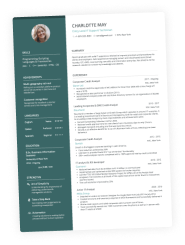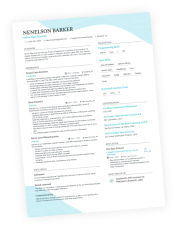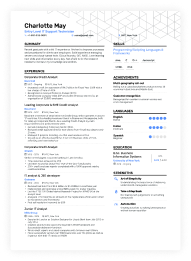Combination Resume Templates
Use a combination resume template in case you’re switching career fields and you want to focus on your transferable skills. To start, simply select your favorite-looking resume design below, and replace the info with your own.

Elegant
Combination resume template. The right column has a color accent for maximum contrast and focus. Perfect for experienced candidates changing career fields.

Double-Column
Hybrid resume template. Our most-used template with a hybrid take. Great fit for an early start after a career switch.

Modern
Combo resume template. A more compact design allows for adding extra content to make it a truly personalized resume.

Modern #2
We love our modern resume template, so here's a second iteration of it. We combine the best of both chronological and functional resumes, making it suitable for a wide range of careers and experience levels.

Polished
Innovative resume template. A mix of new features and eye-catching elements, making it good for creative professionals in fields like design, technology, and advertising. Fitting for mid- to senior-level professionals.

Ivy League
Comprehensive resume template. A mix of design that shows a complete picture of your skills, experience, and career history. This makes it a great choice for many professionals.
What is a combination resume?
The combination resume format, or hybrid resume template, is a combination between the reverse-chronological and the functional resume format. It is designed for highly-trained jobseekers with previous work experience because it places equal emphasis on both your skills and work experience.
This format presents your job history overview in reverse chronological order and gives detailed information about your transferable skills and qualifications.
The combination resume isn't for everyone. Most hiring managers are expecting candidates to provide chronological resumes.
However, you can use a combination resume format in specific situations. For example, if you're a senior-level candidate with various skills and experiences, or you're going through a career change.
If you want to create the best resume for your dream job, you can always count on Enhancv resume builder.
When to use a combination resume format?
A combination resume format has a detailed skill section that groups them into categories to show off your skills and achievements. In addition to this section, this resume format also includes your work history.
People who seek a career change use the combination resume format. It allows them to emphasize certain skills from their past jobs to make their application more attractive to recruiters. And at the same time, they can give more detailed examples of those skills in the work experience section.
Most recruiters are looking to see a highlight of your top career achievements and relevant job experience in your resume’s work experience entries. That's why hybrid resume formatting is more often used than functional ones.
This is a good resume format for people who have learned a lot of skills and want to show them on their resume. These candidates are probably applying for senior jobs and have a long work history to display on their resumes.
You can use the hybrid resume format to apply to all kinds of companies and jobs. However, keep in mind to adjust the design depending on your position and the type of company. Use a modern design when you're applying to more creative and new companies. But it's best to keep your resume clear and more conservative when you're applying for a more traditional field or company.
Tips for building the best combination resume
Now that you have an idea of the definition and when to use a combination resume format, here's the actual structure of it:
Design
A well-written and designed combination resume can be a powerful tool for promoting a professional image and getting a job interview. The design of your resume can make it easy to read and highlight the two main sections—your skills and work experience.
If you're applying for a creative job or in a company with a new field, use a modern design. You can use graphics and different icons to make it stand out.
However, if your field is more conservative, it's advisable to use a more business/traditional design. No matter which design you choose, your resume has to have a clear separation and formatting between each section.
Font
The most important thing about choosing a font is that it's easy to read. You can use more traditional ones like Times New Roman and Helvetica or Arial and Calibri, which are considered to have a more modern look. On our templates, we use Lato, which has all the best features a font can offer, plus it's just as ATS-friendly as Arial.
Colors
it's
If you're applying for a more traditional company and position, you should probably use only black and white for your resume. Meaning white for the background, and black for the text.
High contrast between the background and the letters makes reading easy. That’s why this is one of the most preferable color combinations.
However, you can add a dash of color here and there to make a recruiter’s experience more pleasurable. Pick a well-contrasting color for fonts and subheadings to increase readability. Choose from a blue, dark red, or green color palette.
Select the best layout
When you use а combination resume, it's advisable to follow a proper layout. Typically, you should include the following main sections: contact information, resume summary, work experience, and additional skills and education.
The header of your resume is the place to put your full name and professional title. Include your contact information like an email, phone number, and location—only the city/state (recruiters aren't interested in your exact address).
You can include a professional link like your LinkedIn profile or portfolio website. Remember that you aren't obliged to provide a headshot unless requested in the job listing.
Your resume summary is the first thing the recruiter sees on your resume. That’s why it's important to put in extra effort to catch their attention. Describe in a couple of sentences your career highlights, qualifications, and relevant skills.
The following section can be your skills or work experience—it'll depend on your particular case. If you're writing a resume for a career change, you should first list your skills and then your professional history.
When writing your skills section, you should list them by relevance to the position you're applying for or start with the transferable skills first. Include the best achievements related to the skill you're talking about. Show that you're good at it, using numbers if you can, and be as specific as possible.
List your work experience by starting with your most recent position and continue in reverse chronological order. Using bullet points, list up to 5 responsibilities and achievements in each of the roles you’ve been in, and add metrics to illustrate specific accomplishments.
When you're writing your education section you should have in mind to list a few essential pieces of information: the name of the school, location, degree you obtained, field of study, and graduation year. Also list any relevant honors or academic recognition, activities, or other achievements obtained during your education. If you have any certifications or courses that are related to your work experience or the job you're applying for, add them too.
Combination resumes give a lot of space to your experience and skills. You can put the information on your resume in one or two columns, depending on how long the text is.
Number of pages
If you're an entry-level candidate, your combined resume most likely will only be one page long. Most recruiters prefer one page, but if you're a senior-level candidate and have a diverse range of experience and skills, your resume could easily become two pages.
Combination resume template pros and cons
Pros
- Hybrid resume templates are focused at the same time on your skills and work experiences.
- A combination resume format is a good choice for senior-level professionals.
- The combined resume is suitable for candidates with diverse employment histories and transferable skills.
Cons
- The combination resume format can be confusing for the recruiters if not well organized.
- For some recruiters, combined resumes can de-emphasize the candidate’s job tasks and responsibilities.
- The hybrid resume templates require more effort and creativity to prepare.



